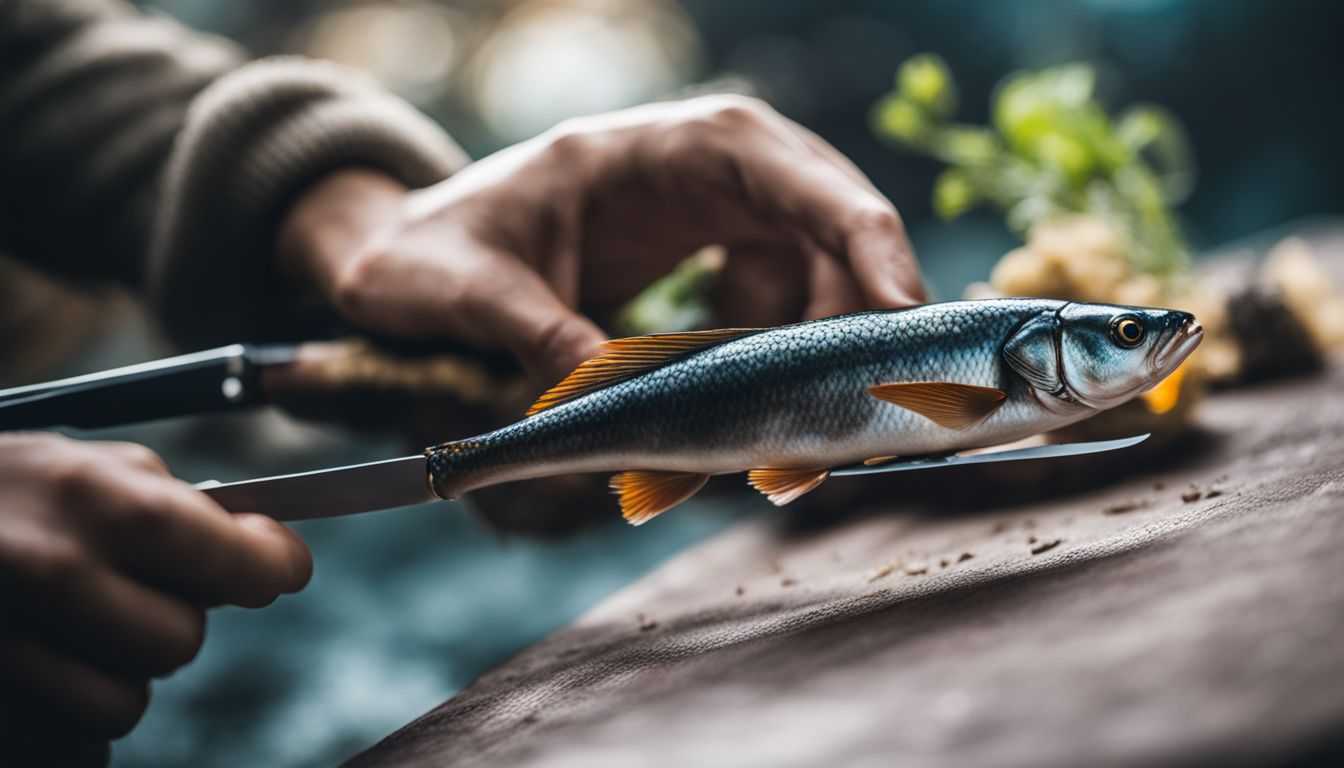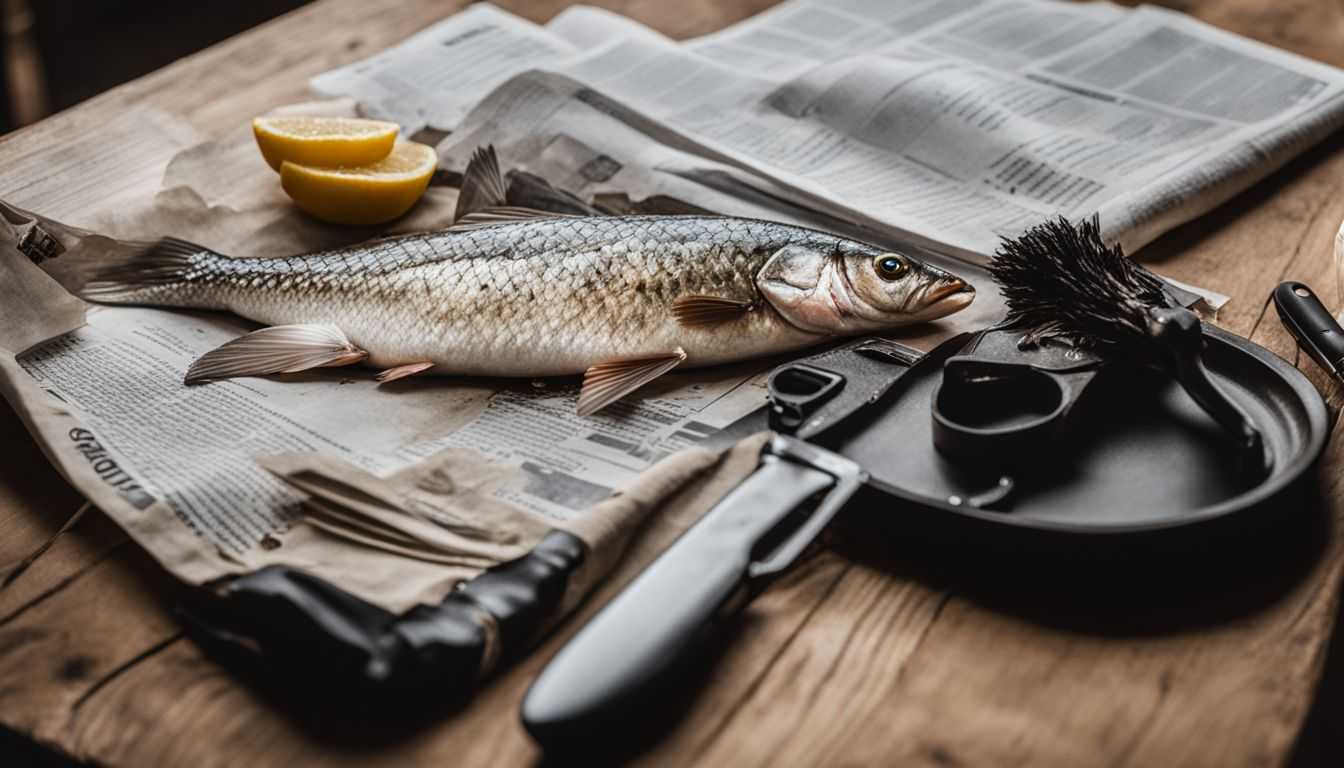Caught a fresh one and ready to cook but baffled on how to scale it properly? Many anglers find fish scaling challenging; however, it’s crucial for the best cooking results. This guide breaks down an easy, step-by-step process on how to masterfully scale a fish, from necessary tools to tips and tricks.
Read on: you’re closer than ever before to your perfectly prepared seafood dish!
Key Takeaways
- Scaling a fish is important for good cooking because it improves the taste and removes rough scales that can spoil your meal.
- To properly scale a fish, you will need newspaper to cover your workspace, a fish scaler or knife for scraping off the scales, and optionally, a trash bag to minimize mess.
- Steps to scale a fish include rinsing it under running water, holding it firmly while scaling from tail to head, paying attention to the edges and collar, removing the guts and liver with a knife, snipping off the gills with kitchen shears (optional), and thoroughly rinsing the fish after scaling.
- Tips for easier scaling include using a trash bag as an apron to catch scales, wearing gloves for hand protection, and ensuring proper hand hygiene before and after handling the fish.
Why is Scaling a Fish Important?
 Scaling a fish is key to all great cooking. It helps improve the taste. Also, eating scales is not fun at all. They feel rough in the mouth and can spoil your meal.
Scaling a fish is key to all great cooking. It helps improve the taste. Also, eating scales is not fun at all. They feel rough in the mouth and can spoil your meal.
A fresh catch needs scaling before it hits the pan. This step is also needed for whole fish bought from stores that have not been cleaned yet. So, if you love fish, learn this skill well!
Materials Needed

To properly scale a fish, you will need newspaper to cover your workspace, a fish scaler or knife for scraping off the scales, and optionally, a trash bag to minimize mess.
Newspaper
You will need a newspaper to scale your fish. A large sheet of newspaper is great to use as a work surface. It catches the scales as they fall off. This makes your job easy and less messy.
If you put the fish on several sheets of newspaper, it helps with cleanup after scaling. You can also use the newspaper to wipe your fish and keep it dry. Believe it or not, this simple piece of print media can save you lots of cleaning time.
A fish scaler or a knife
You need a fish scaler or knife for this task. A fish scaler is a tool with bumpy metal parts. It pulls off scales well and keeps the fish safe from cuts. The back of a butter knife can work, too, if you don’t have a scaler.
This kitchen tool helps fetch the scales off without much mess. Using them, your grip stays strong while scaling from tail to head and around the edges. These tools make cooking fish easier and cleaner!
Trash bag (optional)
If you want to avoid a big mess when scaling a fish, using a trash bag is optional but highly recommended. It can protect the area where you’re working from flying scales and make cleanup much easier.
Plus, if you have a trash bag handy, you can use it to dispose of any discarded scraps and carcasses during the cleaning process. Just collect all the guts, heads, and scales in the bag before tossing it out.
Alternatively, you can also wrap them in newspaper before putting them in the garbage for easy disposal. So grab a trash bag or two before you start scaling your fish for an easier cleanup afterwards!
How to Scale a Fish in 6 Steps
To scale a fish, start by rinsing it thoroughly. Then, hold the fish firmly and scrape off the scales from tail to head using a fish scaler or knife. Be sure to also scale the edges and collar of the fish.
Once scaled, remove the guts and liver before snipping off the gills. This step-by-step guide will help you prepare your fish for cooking – read on to discover more tips and tricks!
Rinse the fish
To start scaling a fish, it’s important to rinse it first. Rinsing the fish under fresh, cold running water helps to loosen the scales and make them easier to remove. You should grasp the fish firmly by the tail and hold it under the cold running water.
This will ensure that any loose scales are rinsed away. After scaling and cleaning, remember to give the fish a final rinse under running water to remove any residue or remaining scales.
By rinsing the fish properly, you’ll be on your way to preparing it for cooking in no time!
Hold the fish firmly
Hold the fish firmly to make sure it doesn’t slip out of your hands while scaling. This will help you have better control and reduce the risk of getting hurt. By maintaining a steady grip on the fish, you can scale it more efficiently and effectively.
It’s recommended to securely hold the fish with one hand while using the other hand to scale. Make sure to keep a tight grip throughout the process, as this will ensure that the scales are removed evenly and thoroughly.
Scrape off the scales from tail to head
To properly scale a fish, it’s important to scrape off the scales from tail to head. Using either a fish scaler or the blunt edge of a knife, make steady motions and small back and forward movements along the fish’s body.
This helps remove any dirt, impurities, and bacteria that may be on the skin. If you don’t have a scaler, you can also use a spoon or the sharp edge of a knife. Scaling from tail to head ensures thorough cleaning and prepares the fish for cooking.
Scale the edges and collar
To properly scale a fish, don’t forget to pay attention to the edges and collar. These areas can be easily overlooked, but they also have scales that need to be removed. Use your fish scaler or knife to scrape off the scales from these parts of the fish.
Make sure you’re thorough in removing all the scales so that you end up with a perfectly scaled fish ready for cooking.
Remove the guts and liver
To properly scale a fish, you need to remove the guts and liver. This step is important because it helps clean the fish and prepare it for cooking. Using a simple butter knife, make a slit along the belly of the fish to access the guts.
Carefully remove them and set them aside. The liver can be found attached to the guts; you’ll want to take that out as well. After removing everything, wipe down or rinse the fish thoroughly before moving on to the next steps in preparing it for cooking.
Snip off the gills
To properly scale a fish, it’s important to snip off the gills. This step helps in preparing the fish for cooking. Before scaling, you can use kitchen shears to remove the fins of the fish.
By doing this, you make it easier to scale and clean the fish. It’s a helpful tip that can save you time and effort during the scaling process.
Tips & Tricks
To make the scaling process less messy, consider using a trash bag as a makeshift apron to catch any loose scales.
Use a trash bag for less mess
To help make scaling a fish less messy, you can use a trash bag. It’s simple and effective. Just take a large plastic trash bag and place it on your workspace or the area where you’ll be scaling the fish.
The scales that come off will be caught in the bag, making cleanup much easier. A plastic grocery bag may not be big enough, so opt for a larger trash bag to ensure all the scales are contained.
This way, you can focus on scaling your fish without worrying about creating a mess all over your kitchen or outdoor space.
Rinse the fish thoroughly after scaling
After you finish scaling the fish, it’s important to give it a good rinse. Rinsing the fish under cold running water helps to wash away any loosened scales and clean off any residue.
This step is crucial for maintaining hygiene and ensuring that no scales end up inside the fish’s stomach. By rinsing the descaled fish, you can also get rid of any remaining debris or scales that may have clung to its surface during scaling.
So make sure to give your fish a thorough rinse with cold water before moving on to the next steps in preparing it for cooking.
Wear gloves to protect your hands
To keep your hands safe while scaling a fish, it’s essential to wear gloves. Metal-mesh “fish-cleaning” gloves or rubber gloves are great options. These gloves not only protect your hands from the sharp scales but also prevent any potential infections caused by bacteria on the fish.
Additionally, when handling species with sharp fins, spines, or scales, it is highly recommended to use protective fish-cleaning gloves for extra safety. Remember that hand hygiene is crucial before and after handling the fish, so make sure to wash your hands thoroughly even if you’re wearing gloves.
Safety first!
Conclusion
Scaling a fish may seem daunting at first, but with the step-by-step guide provided in this article, it can be done easily and efficiently. Remember to use a fish scaler or the back of a knife, scrape from tail to head, and clean up any mess with newspaper or a trash bag.
With these tips and tricks, you’ll be able to prepare your freshly caught fish for cooking like a pro! Happy scaling!
FAQs
1. Why is it important to scale a fish before cooking?
Scaling a fish removes the scales, which can have a tough texture and impact the taste of the cooked fish. It also helps in getting rid of any dirt or bacteria that may be present on the skin.
2. What tools do I need to scale a fish?
You’ll need a scaling tool like a fish scaler or the back of a knife with small ridges, as well as water and preferably gloves for better grip.
3. How do I properly scale a fish?
Hold the fish firmly by its tail, place your scaler at an angle against the scales, and scrape towards you in quick strokes until all scales are removed. Rinse off any loose scales under running water.
4. Should I scale my fish before or after gutting it?
It’s generally recommended to scale your fish before gutting it, as removing the scales can cause some mess and it’s easier to rinse away loose scales if done first.
5. Can I cook a scaled but ungutted fish?
Yes, you can cook a scaled but ungutted fish; however, removing the internal organs (gutting) is usually done for hygiene reasons and to enhance flavor.
